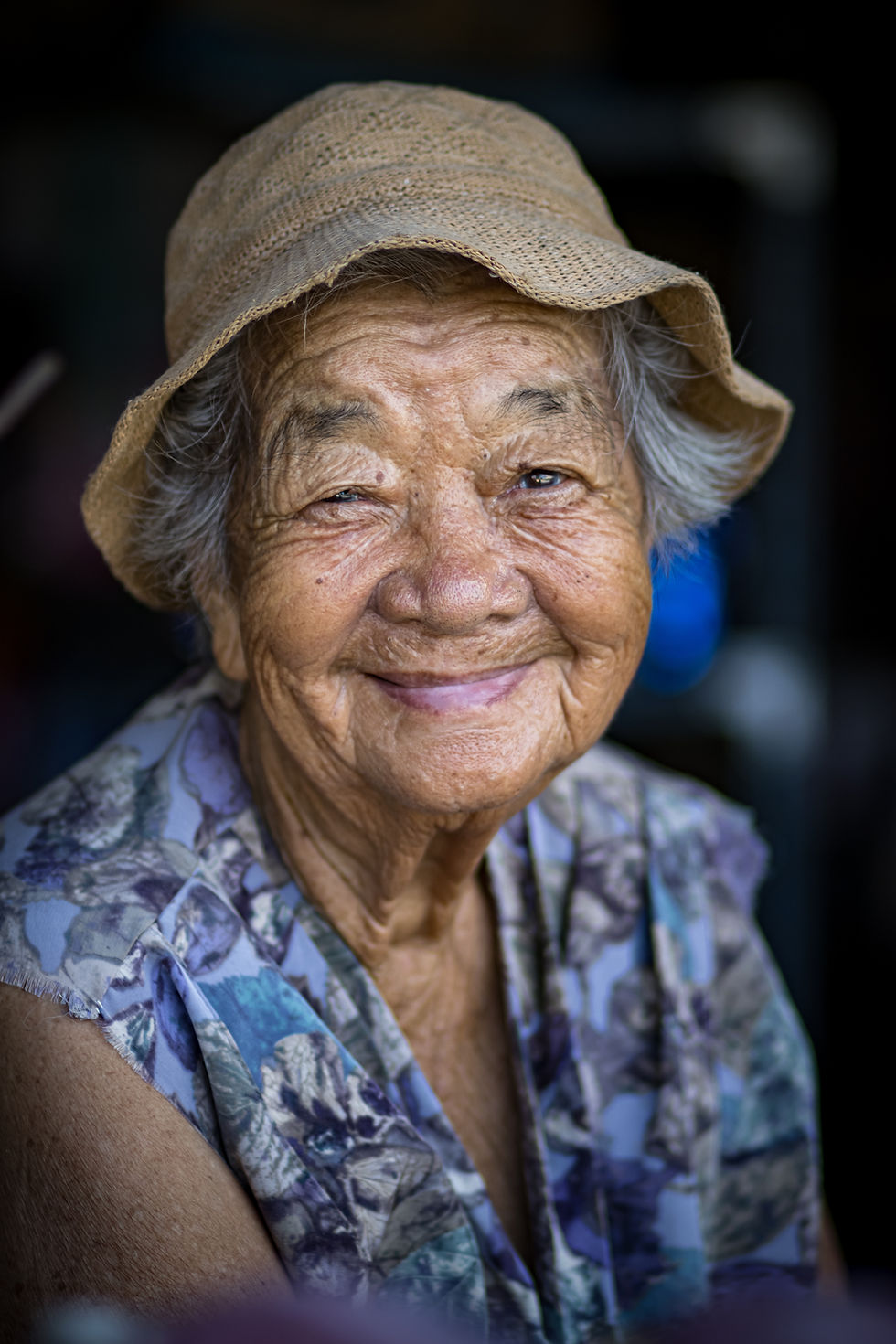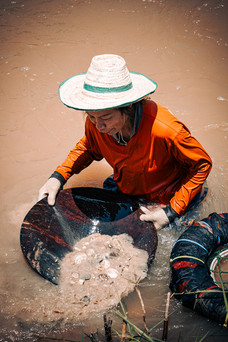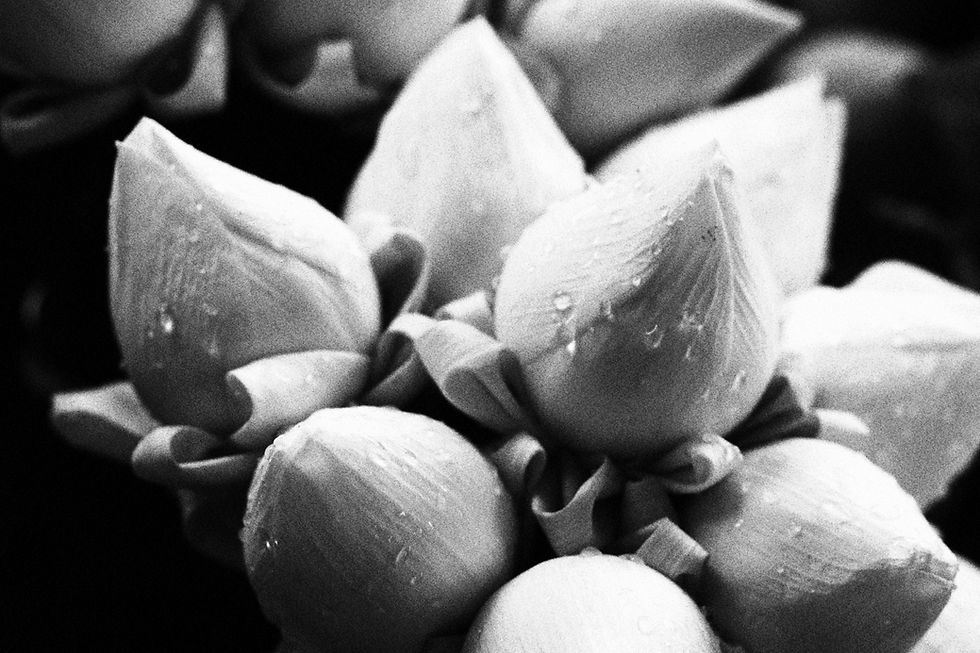Street Portrait Photography in Thailand: How to Build Trust and Capture Powerful Images.
- Tatiana Mocchetti
- Jun 24
- 11 min read
People often ask me how I do it.
How do you ask a stranger if you can take their portrait?
What do you say?
How do you approach someone you’ve never met, camera in hand, and walk away with something that feels so personal?
This post is my way of answering those questions — not as a formula, but as a reflection of how I’ve come to work, connect, and photograph over time.
In a world where so much is taken in a rush — images, moments, faces — I’ve come to believe that the most powerful portraits don’t start with a shutter click. They start with a question.
In my street photography practice across Chiang Mai and beyond, I’ve learned to ask first. A smile. A nod. A gesture. Then, if permission is granted, the image follows. But something surprising happens after that initial connection: I return. Not days later — often just minutes. The camera comes again — but by then, it’s almost invisible. Familiarity lets the guard down. And often, the second image — candid, natural, unposed — holds the real magic.
Later, I bring back a print. Handing someone their portrait — physical, real, in their hands — often says more than the image itself. It says: you’re seen, you’re remembered, you matter.
This post is not just about how to take better street portraits. It’s about how to build trust, return with presence, and give something back.
Because sometimes, the photo you give means more than the one you take.

1. Why Ask for Permission?
When I first began experimenting with portraiture in street photography, I started with my kit lens — the 18–135mm. I kept my distance. I was shy, uncertain, and afraid to approach people directly. So I “stole” portraits from afar, zooming in on faces and gestures without interaction. The images were sometimes visually compelling, but they felt hollow — disconnected from the people within them.
Later, I moved to a 50mm prime lens. It forced me to step closer, to engage, to ask. And that changed everything. I began to build tiny moments of trust, even in a matter of seconds. But I also felt too close — physically and emotionally. Holding a camera just a few centimeters from someone’s face, especially a stranger’s, felt intrusive. I asked myself: Would I feel comfortable being photographed this way?
That’s when I found the 85mm. For me, it strikes the perfect balance — close enough to feel personal, but far enough to offer space, dignity, and presence. It allows me to ask with sincerity, shoot with intention, and still respect the quiet boundary between us. I believe it’s more comfortable for the subject, too. After all, street portraiture shouldn’t feel like a confrontation — it should feel like a conversation.
And that’s why I ask for permission.
In street photography, there's often a romanticized notion of the “decisive moment” — catching an expression in motion, stealing emotion like a visual thief. But portraits are different. A portrait isn’t a lucky shot; it’s a moment willingly offered. It’s a collaboration.
When someone agrees to be photographed, they’re letting you in — not just visually, but energetically. Their eyes hold yours. Their posture changes. The tension drops. And in that softening, something real emerges.
In Thailand, where I do much of my street work, asking carries cultural weight. A polite gesture or a soft-spoken request shows care and consideration. Even when words fail, kindness translates. And more often than not, the answer is yes — not because you asked perfectly, but because you asked at all.
By asking, we’re not just collecting images — we’re building stories. We’re being invited into someone’s moment, if only for a second. And those seconds, I’ve found, are the ones that stay with me longest.
2. How to Approach a Stranger for a Portrait
Asking a stranger if you can take their portrait might be the most intimidating part of street photography — but it can also be the most transformative. It’s not just about overcoming your own shyness; it’s about learning how to invite someone into a shared moment, gently and respectfully.
It Starts Before the Words
Long before you speak, your body language communicates everything. Move slowly. Be relaxed. Let your camera hang by your side for a while. Make eye contact. Smile — not a forced one, but a quiet, human one. Be open, but not demanding. People can sense your intention before they understand your words.
In Thailand, where politeness is deeply ingrained, I usually start with a small “Sawasdee ka”, hands together in a soft wai. I place my hand lightly on my chest, gesture to my camera, then to the person, and say,“Tai ruup dai mai ka?” (Can I take your photo?)Sometimes I also add a light explanation — “You look beautiful” or “I’m a photographer.” But often, the gesture alone is enough.
When someone says yes, it’s not just permission — it’s an invitation.
Creating a Moment, Not Just Taking a Shot
Once permission is given, don’t rush. This isn’t a transaction. Take a breath. Thank them. Let them settle. If they’re doing something — cutting vegetables, folding fabric, sitting in thought — let them continue. Sometimes I take one photo and put my camera down. We smile. They return to what they were doing. Then, when the moment feels right again, I lift the camera and shoot something more natural — something closer to who they really are.
The beauty of asking is that it gives you time. You’re no longer sneaking a moment; you’re part of it.
When Words Don’t Work
There are moments when language fails — no shared words, no time to explain. But even then, gestures go a long way. A soft smile, a slow tilt of the camera, a patient presence. Sometimes they’ll nod. Sometimes they’ll simply look at you and continue with what they’re doing — silently giving their consent.
And if they say no? You smile, say thank you, and move on with grace. That, too, is part of the story.
When Someone Says No
It will happen — and it’s okay. Not everyone wants to be photographed, and they don’t need to justify it. A firm shake of the head, a shy wave of the hand, or even just a look away is enough to know. When that happens, respect it immediately. Lower your camera, smile genuinely, say thank you.
Walk away without showing frustration. That moment is still part of the experience. You asked. They answered. And in that, there was still a kind of connection — one that says: your choice matters.
Sometimes, something beautiful begins after a “no.” The camera goes down, but the conversation begins. I’ve shared laughter, gestures, snacks, even a few words in broken Thai — no photo, but a memory. A real human exchange. And honestly, those moments stay with me just as vividly as the portraits I bring home.
Once, I sat with a woman selling flowers at the edge of the market. She refused the photo gently but asked me to sit. We didn’t share a language, but we shared a quiet ten minutes watching people pass. I left without a picture, but with a warm heart — and that, too, is a gift.
Respect creates trust. And trust creates stories — whether or not there’s a camera between you.
📌 A Special Note on Photographing Children
Photographing children in the street carries a unique responsibility. For me, the rule is simple and non-negotiable:Always ask permission from both the parent and the child.
If I see a beautiful moment involving a child — a quiet glance, a burst of laughter, a hand holding a snack — I first approach the adult. I explain that I’m a photographer and ask if it’s okay to take a photo. If they agree, I turn to the child and ask again, softly, often with just a gesture and a smile.
Sometimes the child is excited. Sometimes they hide behind a shoulder or shake their head. And when that happens, I never insist. I never push. Their comfort comes first.
Even if the parent is encouraging — saying “yes” with a proud smile — if the child says “no” with their body or their eyes, the answer is no.
Some of my most meaningful connections have come not from taking a photo, but from respecting a child’s choice not to be photographed. That, too, is a moment worth honoring.
After all, photography should never take more than it gives.
Don’t Just Be a Photographer — Be a Person
The best portraits I’ve taken have come not from clever angles or perfect light, but from presence. When the person in front of you feels seen, not used. When you’re not just pointing a lens, but offering attention. That small shift can turn a photograph into a memory — for both of you.
3. The Trust Loop: Returning for the Real Shot
There’s a unique magic in asking for permission — not just because it opens the door to take a photo, but because it begins a loop of trust that can deepen in just minutes.
When someone agrees to a portrait, I often take just one or two shots — and then I lower the camera. I thank them. Smile. We share a small moment: a nod, a laugh, a few words exchanged. Then I step away. Sometimes I walk around the corner or pretend to focus on something else. I give them space.
And that’s when it happens — they return to themselves.
The stiffness in their posture softens. They stop posing. They go back to folding a cloth, arranging flowers, sipping tea. And because they’ve already granted me permission, I can quietly lift my camera again — from a distance, gently, without tension — and capture something far more natural, unguarded, human.
This second photo is often the one I cherish most. The first is the connection. The second is the truth.
Returning the Image
Whenever possible, I print the portrait and bring it back. Sometimes later that day, sometimes a day or two after, if I know where to find them. I hand it over with two hands, as is the custom in Thailand. No words are needed. The expression on their face — surprise, joy, disbelief — stays with me long after.
I’ve seen someone clutch their portrait to their chest. I’ve watched a vendor pass it to their child, beaming. One woman simply touched her own face in the photo and whispered something I didn’t understand — but I felt the meaning in my bones.
That moment, for me, completes the loop.You don’t just take a portrait. You’re given it. And when you give it back, you give the moment permanence — to them, not just to your portfolio.
It’s no longer just an image. It’s a shared memory.

4. Giving the Photo Back
There’s something deeply powerful about handing someone their own image — not on a screen, not filtered, not fleeting, but printed. Tangible. Real.
After photographing someone in the street — especially when we’ve shared a moment of connection — I often return with a print. Sometimes later that day, sometimes the next morning, especially if I know they’re a vendor or someone who regularly works in the same spot.
I hand the photo over with two hands, following Thai custom. No need for words. The reaction is often soft and honest: a surprised laugh, a proud smile, sometimes a quiet silence as they study their own face.
It’s one thing to ask for a portrait. It’s another to return it.
Some hold it carefully, like something precious. Others show it to a friend or tuck it into a wallet. One elderly woman tapped her image gently and said something I didn’t understand, but her eyes filled with light. In that moment, I felt the loop close — not just a photo given, but a memory completed.
Why It Matters
Street photography often feels fast: shoot, move, shoot, scroll, post. But giving the image back slows everything down. It turns a fleeting exchange into something lasting — for both you and the person you photographed.
It also holds you accountable. If you know you might return with a photo, you shoot with more care. You’re not just composing an image — you’re honoring a person.
Giving It Back — Instantly
This quick exchange often sparks another layer of connection. It makes the experience immediate and joyful. I've had people set the photo as their profile picture while I was still standing next to them.
Not Every Photo Can Be Returned
Of course, there are times when I don’t know how to find someone again. The moment was spontaneous, the subject already gone. But when I can return, I do.
And when I do, it’s no longer just my photo — it’s ours.
5. Tips for Photographing Street Portraits Respectfully
This section brings everything together — the emotional awareness, the technical skill, and the cultural sensitivity — and turns it into practical, repeatable habits for capturing street portraits with integrity.
✧ Be Present First, Then Be Photographic
Before thinking about composition, light, or lens choice, be present. Look people in the eye. Be curious about them as people, not just subjects. When you focus on being human first, your images will reflect that.
✧ Choose the Right Lens for the Space Between You
As I shared earlier, I often use an 85mm lens for street portraits. It allows me to keep a respectful physical distance while still capturing intimacy in the subject's expression. A 50mm is excellent too, but requires you to be closer — which can work in quieter moments or when a relationship has been established.
Whatever focal length you use, make sure it reflects your comfort and your subject’s. If the lens feels intrusive, the photo probably will too.
✧ Light Is Emotion — Use It Wisely
Soft natural light is your best friend. Early morning and late afternoon offer beautiful, diffused tones. Look for open shade if the sun is harsh, or try shooting backlit with a wide aperture for dreamy softness.
Even in street environments, light tells half the story. Watch how it falls on a face, how it shapes mood, how it separates your subject from the background. Wait for the light, and your photo will wait with you.
✧ Be Transparent and Honest
If someone asks why you’re taking photos, tell them. Show them the image. Explain your project or your intention. You don’t need a business card or a pitch — just honesty. People respond to sincerity more than perfection.
✧ Don’t Just “Take” — Participate
Photography is often described as “capturing” a moment, but the best portraits happen when you participate in that moment. You’re not invisible. Your presence affects the scene. Embrace that, and make it collaborative.
And once the photo is taken — if you can — give something back, even if it’s just your attention, your time, or a few printed portraits returned a week later.
6. Final Thoughts: The Portrait Is Not the Point
Street portrait photography isn’t just about sharp focus or perfect lighting. It’s about building moments of trust — sometimes in seconds. It’s about asking permission, observing gently, returning with presence, and remembering that every face carries a story far bigger than the frame.
Whether I’m handing back a printed photo or sharing it instantly via Bluetooth, I’ve come to realize that the real gift isn’t the image itself — it’s the connection. That quiet exchange, that moment of being seen and acknowledged, stays long after the shutter clicks.
And sometimes, there is no photo — just a “no,” a smile, a shared glance. And that, too, is enough.
If you’re looking to dive deeper into portrait techniques — from working with natural light to creative framing and composition — you can also read my previous article:👉 Mastering Portrait Photography: Tips and Techniques for Stunning Shots
That guide focuses more on technical and creative aspects. But here, I hope you found something softer: a way to photograph not just a face, but a moment of respect.
So next time you're out with your camera, try asking. And then—wait. Watch. Return.The best portraits often happen not when we take them, but when we’re invited into them.



























Well said. There have been times when I shoot first and then ask when they notice that I'm there. Long ago, I carried a lot of gear. Now I'm carrying a single DSLR with a fixed focal length lens and zooming with my feet.